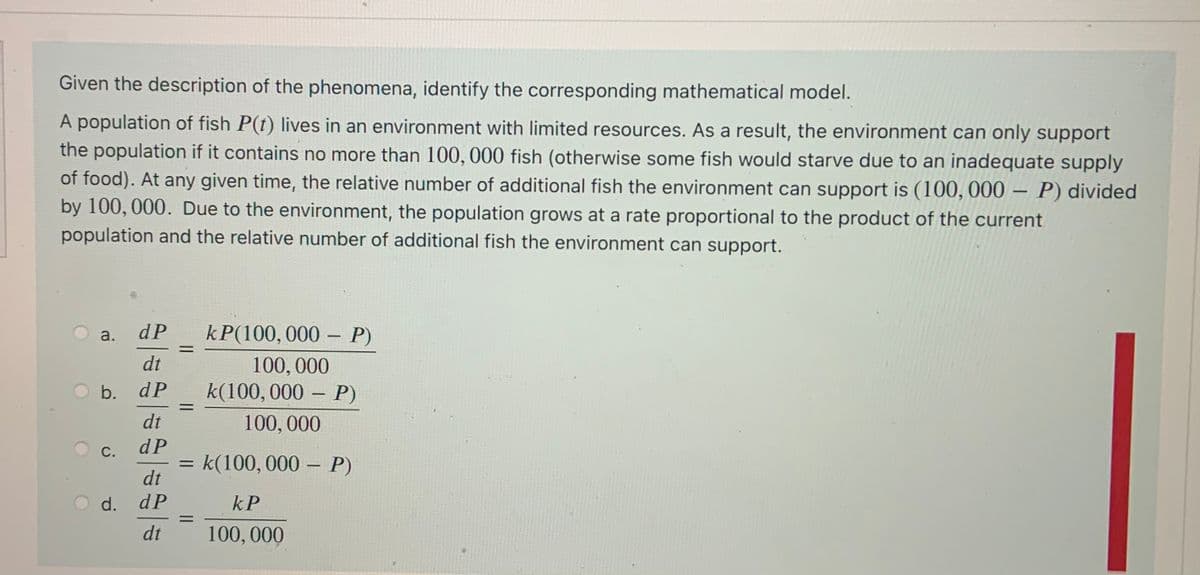Given the description of the phenomena, identify the corresponding mathematical model. A population of fish P(t) lives in an environment with limited resources. As a result, the environment can only support the population if it contains no more than 100, 000 fish (otherwise some fish would starve due to an inadequate supply of food). At any given time, the relative number of additional fish the environment can support is (100, 000 - P) divided by 100, 000. Due to the environment, the population grows at a rate proportional to the product of the current population and the relative number of additional fish the environment can support. O a. dP k P(100, 000-Р) dt 100, 000 k(100, 000 – P) Ob. dP dt 100, 000 С. dP = k(100, 000 - P) dt O d. dP kP dt 100, 000
Given the description of the phenomena, identify the corresponding mathematical model. A population of fish P(t) lives in an environment with limited resources. As a result, the environment can only support the population if it contains no more than 100, 000 fish (otherwise some fish would starve due to an inadequate supply of food). At any given time, the relative number of additional fish the environment can support is (100, 000 - P) divided by 100, 000. Due to the environment, the population grows at a rate proportional to the product of the current population and the relative number of additional fish the environment can support. O a. dP k P(100, 000-Р) dt 100, 000 k(100, 000 – P) Ob. dP dt 100, 000 С. dP = k(100, 000 - P) dt O d. dP kP dt 100, 000
Algebra & Trigonometry with Analytic Geometry
13th Edition
ISBN:9781133382119
Author:Swokowski
Publisher:Swokowski
Chapter5: Inverse, Exponential, And Logarithmic Functions
Section5.6: Exponential And Logarithmic Equations
Problem 64E
Related questions
Question

Transcribed Image Text:Given the description of the phenomena, identify the corresponding mathematical model.
A population of fish P(t) lives in an environment with limited resources. As a result, the environment can only support
the population if it contains no more than 100, 000 fish (otherwise some fish would starve due to an inadequate supply
of food). At any given time, the relative number of additional fish the environment can support is (100, 000 ·
by 100, 000. Due to the environment, the population grows at a rate proportional to the product of the current
P) divided
population and the relative number of additional fish the environment can support.
dP
kP(100,000 – P)
a.
%D
dt
100,000
k(100, 000 – P)
b. dP
%3D
dt
100, 000
C.
dP
= k(100, 000 – P)
dt
O d.
dP
kP
%3D
dt
100, 000
Expert Solution
This question has been solved!
Explore an expertly crafted, step-by-step solution for a thorough understanding of key concepts.
Step by step
Solved in 2 steps with 1 images

Recommended textbooks for you

Algebra & Trigonometry with Analytic Geometry
Algebra
ISBN:
9781133382119
Author:
Swokowski
Publisher:
Cengage

Algebra & Trigonometry with Analytic Geometry
Algebra
ISBN:
9781133382119
Author:
Swokowski
Publisher:
Cengage